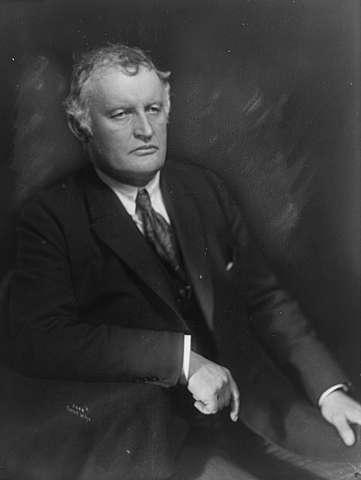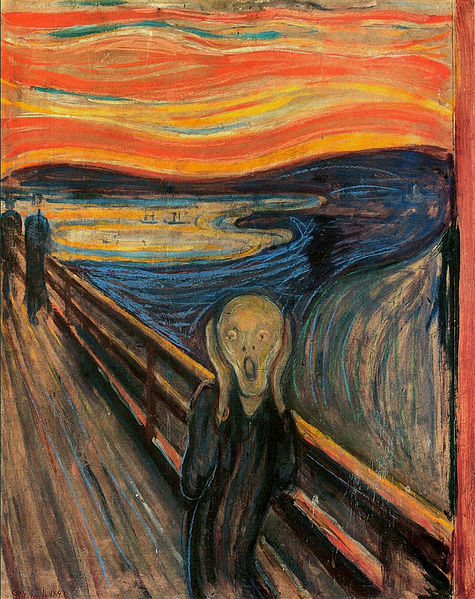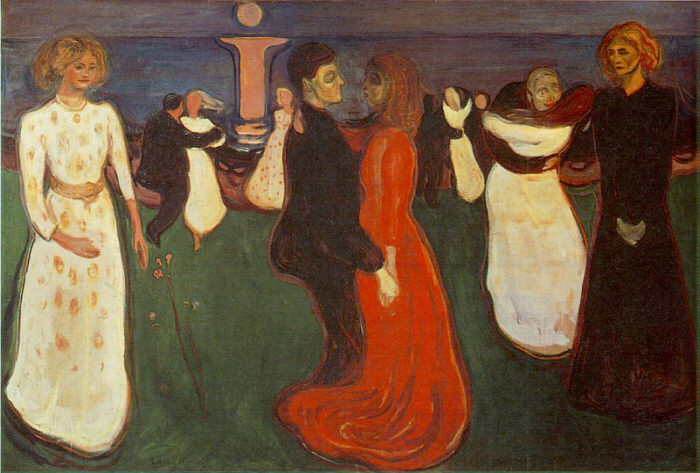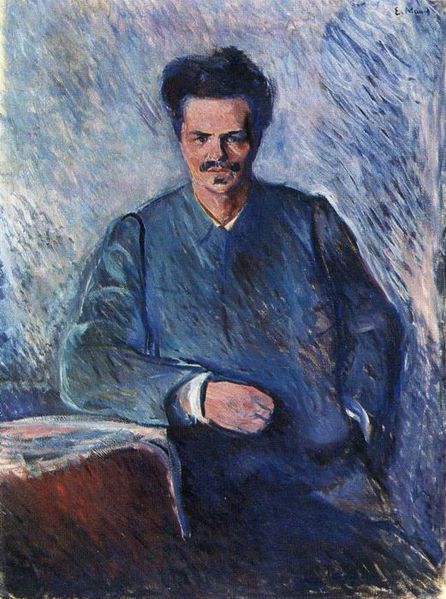| Edvard Munch | |
|---|---|
 |
|
| Born | Dec. 12, 1863 Ådalsbruk in Løten, Norway |
| Died | Jan. 23, 1944 (at age 80) Oslo, Norway |
| Nationality | Norwegian |
| Movement | Expressionism |
| Field | Painting |
| Famous Paintings by Edvard Munch | |
| The Scream | |
| The Sick Child | |
| Death in the Sickroom | |
| The Dance of Life | |
| Madonna | |
| Vampire | |
| Anxiety | |
| Ashes | |
| Puberty | |
| Complete Works |
Born on December 12, 1863, in Løten, Norway, Edvard was the second of five kids. His dad was a doctor, and a really pious man, whose extreme religious views left a lasting, obsessive impression on him throughout his whole life. His family moved to Oslo the year after he was born, because his dad had gotten a job in the area.
Edvard was born ill, and remained ill throughout much of his childhood. He wasn’t allowed to attend school during the winter, and only sometimes during the spring. In 1868, his mom died of tuberculosis, which deeply affected him. He had been really close to his mom, even though he was only five when she died. His father had to raise the kids alone, and to keep them from getting into trouble, he often told them, “Mother is looking down from heaven and grieving at misbehavior.”
In 1877, his oldest sister died from tuberculosis, too. This was the only sibling he was close to, and it upset him that his two favorite people in his world were gone. He became slightly paranoid, thinking that death was following him everywhere. He had nightmares about this, and his art reflects them later on.
His father forced him to go to technical school in 1879 to become an engineer. Edvard excelled at physics, chemistry, and math, and his father believed that he might actually achieve his goal. Edvard dropped out about a year after starting. He wished to be an artist, like some of his ancestors had been. His father hated it, calling art an “unholy trade.”
He enrolled at the Royal School of Art and Design in 1881. It was founded by his relative, Jacob Munch, and he felt that he had a connection with the school. His first exhibition was in 1883, where he and other fellow students all had their art on display. Many of these earlier works are naturalistic and impressionistic, unlike all of his later works. They reflected the atmosphere around him, the landscape, and the people; but he never really liked any of them. He couldn’t figure out what he was doing wrong.
 Later that year, Edvard and his father got in a huge fight. His dad ended up destroying one of his paintings, and then refused to pay for art school or supplies. The split was permanent, and Edvard never talked to his father again. He soon became friends with Hans Jæger, a young extremist who lived near Edvard. Jæger believed that suicide was the ultimate freedom, and Munch came to believe that too. Jæger also suggested that Edvard should paint from his personal experiences, rather than just random subjects.
Later that year, Edvard and his father got in a huge fight. His dad ended up destroying one of his paintings, and then refused to pay for art school or supplies. The split was permanent, and Edvard never talked to his father again. He soon became friends with Hans Jæger, a young extremist who lived near Edvard. Jæger believed that suicide was the ultimate freedom, and Munch came to believe that too. Jæger also suggested that Edvard should paint from his personal experiences, rather than just random subjects.
In 1886, he held an exhibition in his home town of Oslo, with his new pieces he had been working on. The town people revolted. They said the paintings were too violent, too macabre to be put on display. One of the ones he showed at the time was The Sick Child, finished right before the show. It portrayed his sister on her deathbed, and he and his mom around the bed. The colors were all dark and dreary to set the mood, and it was painted with long, quick brush strokes, which makes the painting seem more violent than it is.
Three years later, he traveled to Paris. Edvard went to all the impressionism and post-impressionism shows to try to gain some new techniques and ideas. He disliked Monet, thought Van Gogh was alright, and absolutely loved Paul Gauguin’s work. Edvard said it was “reaction against realism” and that “art was human work and not an imitation of nature in Gauguin’s paintings.” Gauguin would take humans, and instead of painting every detail, he would simplify them, and Munch was very impressed with that.
 In December, Edvard’s dad died, leaving the family in squalor. He assumed the responsibility for his family, but became extremely depressed. His paranoia came back from his childhood, and he thought death was chasing after him again. “I live with the dead-my mother, my sister, my father… kill yourself and then it’s over, why live?” Thoughts of suicide were everyday, but he never acted upon them. Edvard still painted during this time, and was experimenting with pointillism.
In December, Edvard’s dad died, leaving the family in squalor. He assumed the responsibility for his family, but became extremely depressed. His paranoia came back from his childhood, and he thought death was chasing after him again. “I live with the dead-my mother, my sister, my father… kill yourself and then it’s over, why live?” Thoughts of suicide were everyday, but he never acted upon them. Edvard still painted during this time, and was experimenting with pointillism.
In 1892, the Union of Berlin Artists invited Munch to its November exhibition. Munch went, but the show closed after one week, because his paintings had caused so much disruption among the critics. Munch said afterwards, “Never had I had such an amusing time-it’s incredible that something so innocent as painting could have created such a stir.”
The next year, Edvard painted The Scream, his most famous painting. It depicts a guy on a boat, gaunt and hollowed, screaming with the glare of an orange sunset behind him. He says he got the inspiration for the painting when he and a friend were walking on the street, and his friend turned around to look at him, then the idea popped into his head. The Scream is considered one of the most identifiable paintings ever created, and it conveys such expression, that the viewer can sense it while looking at the picture.
 Edvard had another exhibit in Paris in 1896, and this time he was favored by the critics. They liked his work, calling it “avant guard” and other notable terms. He sold some paintings there, and returned home a considerably wealthier man. He bought the “Happy House” later that year, and lived in it every summer until he died. It’s nicknamed the “Happy House” because that is the only place Edvard ever loved, and he was the happiest when he lived there.
Edvard had another exhibit in Paris in 1896, and this time he was favored by the critics. They liked his work, calling it “avant guard” and other notable terms. He sold some paintings there, and returned home a considerably wealthier man. He bought the “Happy House” later that year, and lived in it every summer until he died. It’s nicknamed the “Happy House” because that is the only place Edvard ever loved, and he was the happiest when he lived there.
In 1899, he began to have an intimate relationship with a woman named Tulla Larsen. She was an upper class lady, who was several years older than him. They traveled to Rome together, and she expected Edvard to propose to her. He never did, and when they returned home to Germany, she proposed to him. He gave in under pressure, but then ran away to Paris. Tulla followed him there, but he denied her again, so she married one of his younger colleague. He felt betrayed, and painted the scene in several paintings.
In autumn of 1901, Edvard began to have paranoia and hallucinations every day. He entered the clinic of Dr. Daniel Jackson and for the next eight months, he was subjected to electric shock treatments, and kept on a diet. In 1909, Museums began buying his paintings, which increased his financial stability. He traveled to New York in 1912, and held an exhibition there, which was a success as well. Unfortunately, World War I began, and his patrons were either pushed underground or killed in Germany. The Nazi movement grew with popularity after the war ended, and Munch’s paintings were put on the banned list.
Edvard spent the last two decades of his life living in Skøyen, Oslo. Every day he feared that the Nazi’s would invade his home, and take away all his art, which he kept in the attic. He was deeply hurt because of what Germany was doing, for he loved the country, and considered it his home. In the 1940’s, the Nazi’s officially took over the government, and he feared for his art even more. The pieces that had been in German Museums had been removed, and either destroyed, put into warehouses, or smuggled out to the Netherlands. Edvard died on January 23, 1944. The Nazis held his funeral for him, giving the appearance that he was a Nazi sympathizer, which he was not. All his works were left to the city of Oslo, where the Munch Museum is located. Out of the 82 pieces that the Nazi’s confiscated, 71 have been found.